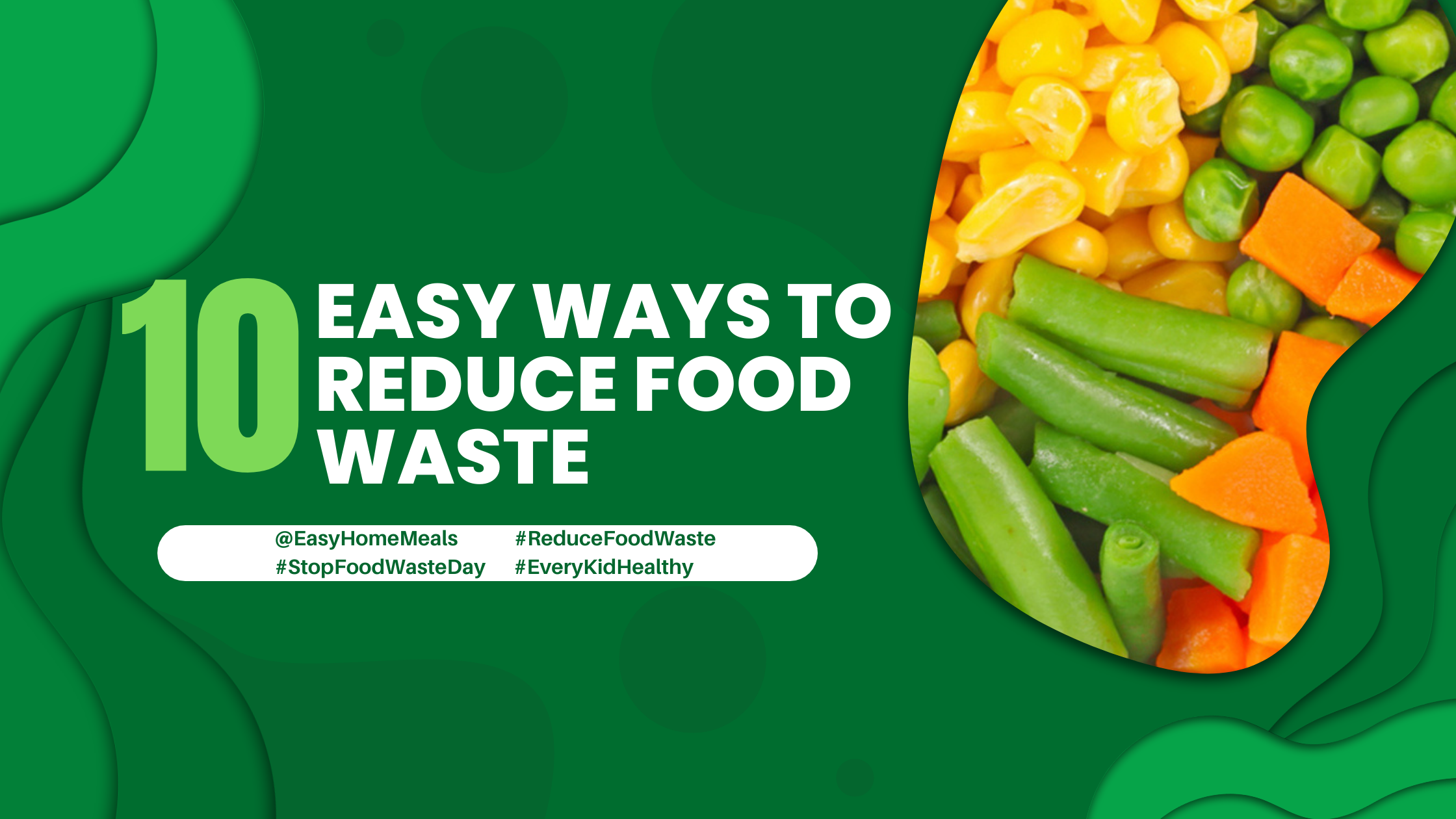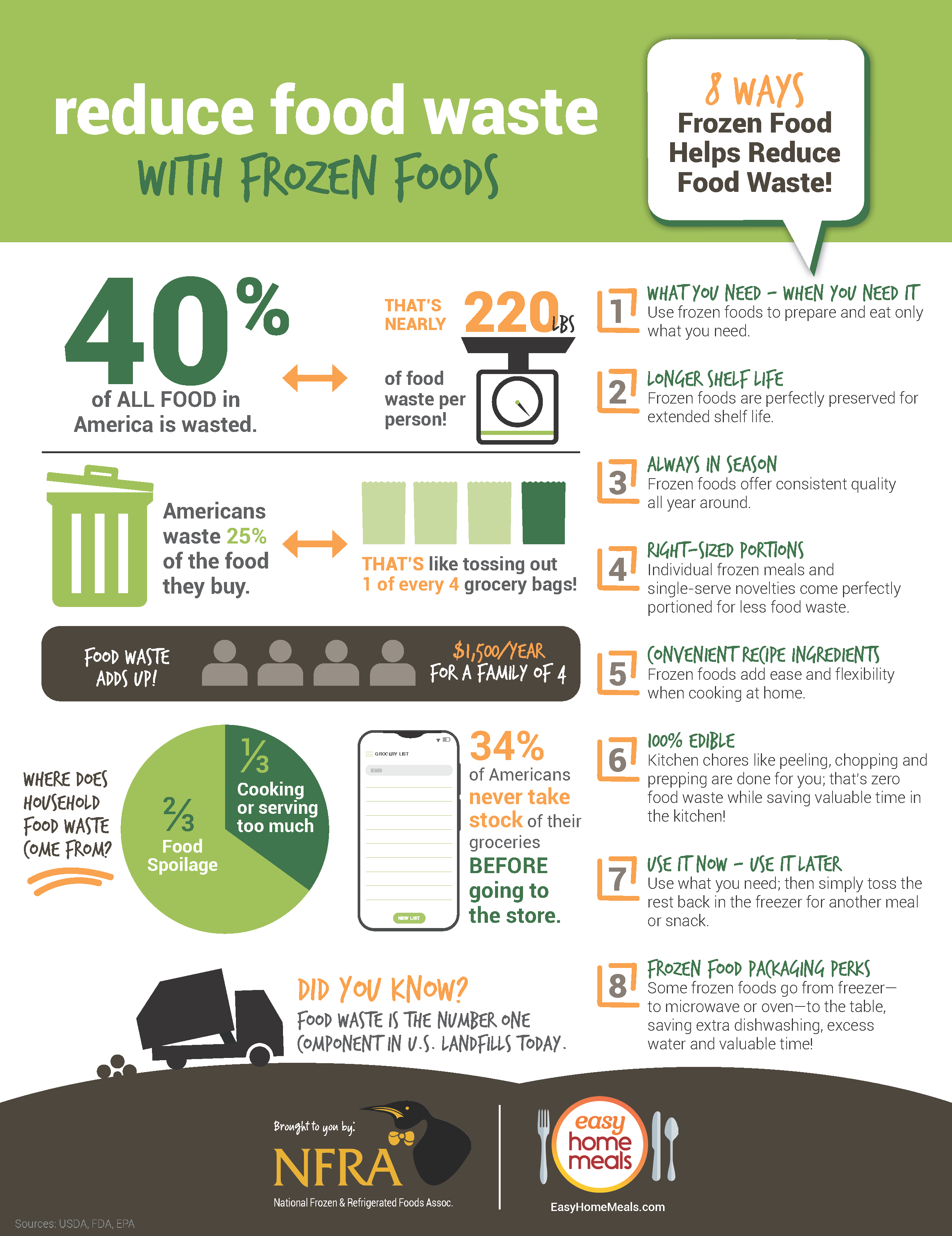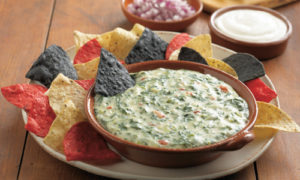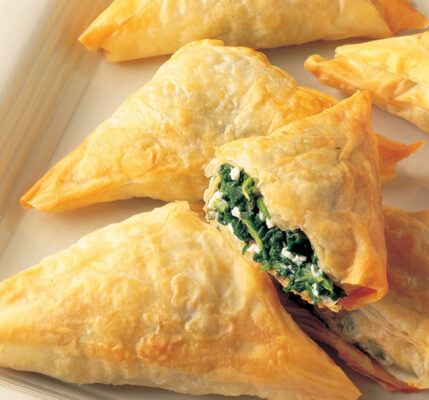10 Ways to Reduce Food Waste

It is critically important to reduce food waste. The United Nations estimates we will need 50% more food by 2050 to feed the growing global population. Here in the U.S., 40% of all food doesn’t get eaten. In fact, food waste is the number one component in landfills today, helping to make landfills the 3rd largest source of methane gas. According to the United States Department of Agriculture (USDA), about 220 pounds of food is wasted per person in American per year. The Environmental Protection Agency (EPA) aims to cut food waste going to landfills in half (to 110 pounds per person) by the year 2030.

Is Good Food Going to Waste in Your Home?
Americans waste 25% of the foods they buy. That’s like tossing away 1 of every 4 grocery bags of food purchased. Buying food and later throwing it out is not only a waste of money; it also hurts the environment. About 2/3 of household food waste is due to food spoilage, while the remaining 1/3 is due to cooking or serving too much food.
Are You Aware of Food Waste?
A recent Deloitte Survey indicates 7 out of 10 consumers think about food waste and how much they throw away. Awareness is an important first step to preventing food waste. The good news is, you can help with simple shifts in how you store, prepare and shop for food.
Try these 10 easy ways to reduce food waste in your home:
1. Take Stock of Your Fridge, Freezer and Pantry
Did you know, 34% of Americans never take stock of groceries on hand prior to going to the supermarket? Think about what you have stored before buying more. Planning meals and making a weekly food shopping list can help you buy what you really need.
2. Use Frozen Foods for Right-Sized Portions
Frozen foods can help you to prepare and eat only what you need. Then, toss the rest back in the freezer for another convenient meal or snack.
3. Think Twice Before Throwing Food Away
Is there a way to turn today’s meal leftover into tomorrow’s portable lunch? Get creative by adding remaining vegetables and meats to soups, omelets and stir fries. When dining out, request a take-out container to repurpose foods and sauces as meal starters and flavoring agents.
4. Visit the Frozen Food Section on Every Grocery Trip
The longer shelf life of frozen foods reduces the chances of spoilage (a key contributor to food waste). Keeping frozen fruits and vegetables on hand ensures you’ll alway have some nutritious foods in the house. And because produce is often flash-frozen within hours of harvest, nutrients are locked and perfectly preserved.
5. Get Kids Involved Early in the Fight Against Food Waste
Teach children ways they can help fight food waste, too. When kids realize food is precious and their choices can make a difference, it creates healthy habits for themselves and for the planet.
6. Label & Date Frozen Foods
By adding a simple label to the foods you pop in the freezer, you can remove the guesswork, make your freezer easier to manage and ensure frozen food is eaten at its best quality. Rotate foods so the first foods purchased are the first ones being used (known as FIFO or First In, First Out).
7. Discover Other Ways to Use the Foods You Don’t Eat
As part of your efforts to reduce food waste, consider donating surplus consumable foods to local food banks, soup kitchens and shelters. You can also compost food scraps to create a nutrient-rich soil amendment for home-garden beds.
8. Plan Weekly Meals Made with Frozen Foods
Frozen choices are available for all meal occasions: Breakfast, Lunch, Dinner and Snacks. Plan at least one meal a week that calls for frozen foods to use the items at peak quality (follow “Use By” and “Best By” dates) and to free up space for additional frozen foods to be added to your freezer. Remember, “Best By” dates speak to the quality of the food rather than its safety, whereas the “Use By” date indicates when food should be discarded.
9. Use Excess Food During Parties & Celebrations
When planning a celebration, ask invited guests to RSVP to help you plan an appropriate amount of food on your entertaining menu. If you still prepare too much, send food home with willing recipients (if the food can be held at safe temperatures throughout). Whenever food safety is in doubt, throw it out.
10. Be Extra Mindful of Food Waste Between Thanksgiving & New Year’s
On average, three times as much food is wasted between Thanksgiving and New Year’s Day than at other times of the year. Take time to plan ways to use holiday leftovers during this festive time of year.
Share your personal efforts with us during Earth Month in April and all year long by posting on your favorite social media channels. Tag us @EasyHomeMeals and use hashtags #ReduceFoodWaste and #StopFoodWasteDay.






